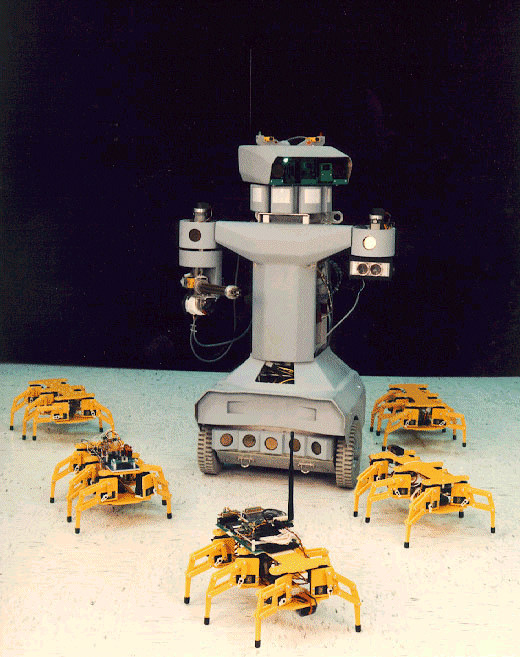The World of Technology
ROBART III (1992-)
ROBART III is intended to be an advanced demonstration platform for non-lethal response measures, effectively extending the reflexive teleoperated control concepts developed on ROBART II into the realm of coordinated weapon control. The basic issue to be addressed is the relative difficulty associated with effectively controlling a mobile robot equipped with a surveillance and/or targeting camera and an articulated weapon system.
Experience gained through actual use by law enforcement personnel of conventional teleoperated devices of this type has revealed considerable shortcomings from a man/machine interface point of view. Simply put, if a remote operator has to master simultaneous manipulation of three different joysticks (i.e., one for drive and steering, another for camera pan and tilt, and yet a third for weapons control), the chances of hitting a moving target are minimal. In actuality, the single task of simply driving a teleoperated platform using vehicle-based video feedback is no trivial matter, and can be stressful and fatiguing even under very favorable conditions.
The innovative thrust behind the ROBART III development is an extension of ROBART II’s reflexive teleoperated control concept one step further, incorporating sensor-assisted weapon control into the integrated package. The philosophy basically involves first making two of the three controllable elements (i.e., drive control, camera control, and weapon control) slaves to the third, so the human operator only has to deal with one entity. For example, the surveillance camera can be slaved to the weapon, so that the camera looks wherever the operator points the gun. If either the weapon pan-axis controller or the camera pan-axis controller approach their respective limits of allowable travel, the robot’s drive controller causes the mobility base to rotate in place in the proper direction to restore the necessary range of motion. Alternatively, the weapon could be slaved to the surveillance camera, and so forth. In all cases, final closed-loop control of weapon pan-and-tilt can be provided by the video motion detector and other on-board sensors.
ROBART III’s head-mounted sensors include two Polaroid sonar transducers, a Banner near-infrared proximity sensor, an AM Sensors microwave motion detector, and a video surveillance camera. The output of the CCD camera is broadcast to the operator over an analog RF link and simultaneously fed to an onboard video motion detector that provides azimuthal data allowing the head pan-axis controller to automatically track a moving target. Azimuthal and elevation information from the motion detector will be similarly fed to the pan-and-tilt controller for the six-barrel pneumatically fired dart gun for purposes of automated weapon positioning. Additional Polaroid sensors and near-infrared proximity detectors are strategically located to provide full collision avoidance coverage in support of the advanced teleoperation features desired.
The non-lethal-response weapon chosen for incorporation into the system consists of a pneumatically powered dart gun capable of firing a variety of 3/16-inch diameter projectiles. The simulated tranquilizer darts were developed to demonstrate a potential response application involving remote firing of temporarily incapacitating rounds by law enforcement personnel. The demonstration darts consist of a sharpened 20-gauge spring-steel wires approximately 3 inches long and terminated with 3/16-inch plastic balls. A rotating-barrel arrangement was incorporated to allow for multiple firings (six) with minimal mechanical complexity. (The spinning-barrel mechanism also imparts a rather sobering psychological message during system initialization.)
The darts are expelled at high velocity from their 12-inch barrels by a release of compressed air from a pressurized accumulator at the rear of the gun assembly. To minimize air loss, the solenoid-operated valve linking the gun accumulator to the active barrel is opened under computer control for precisely the amount of time required to expel the projectile. The gun accumulator is monitored by a Micro Switch 242PC150G electronic pressure transducer, and maintained at a constant pressure of 120 psi by a second solenoid valve connected to a 150-psi air source. All six darts can thus be fired in rapid succession (approximately 1.5 seconds) under highly repeatable launch conditions to ensure accurate performance. A visible-red laser sight is provided to facilitate manual operation under joystick control using video relayed from the head-mounted camera.
The left and right drive tracks are fashioned from 2.5-inch rubber timing belts turned inside out, driven by a pair of 12-volt electric wheelchair motors identical to those used on ROBART II. System power is supplied by a 80-amphour 12-volt gel-cell battery which provides for several hours of continuous operation between charges. A three-axis Precision Navigation TCM Electronic Compass Module provides magnetic heading, temperature, and vehicle attitude (pitch and roll) information to the remote operator. Full-duplex data communication with the PC-based host control station is accomplished via a 9600-baud Telesystems spread-spectrum RF link.
For increased versatility as a response vehicle, the navigation scheme has been specifically modified to support supervised autonomous operation in previously unexplored interior structures. A “human-centered mapping” strategy is employed to ensure valid first-time interpretation of navigational landmarks as the robot builds its world model. The accuracy of the robot’s real-time position estimation (and ultimately the model representation) is significantly enhanced by an innovative algorithm which exploits the fact that the majority of man-made structures are characterized by parallel and orthogonal walls.
Recently a research thrust has been started involving ROBART III in a distributed master/slave network, partly to address the communication degradation problem as ROBART III explores a building. A group of slave robots would follow ROBART III into a building and be deployed at strategic locations to serve as communication relays, rearguard lookouts, expendable point men, or part of a distributed sensor network, preventing an intruder from playing “hide-and-seek” with ROBART III. A fleet of ten Lynxmotion Hexapod II walking robots (six-legged, twelve-servo hexapods featuring two degrees-of-freedom per leg) are currently used to illustrate the feasibility of the master/slave network. The small slave robots perform collision-avoidance, wall-following, and doorway-detection routines using algorithms similar to those running on ROBART III. For all other tasks, the slaves react to information that has been gathered and preprocessed by ROBART III.
For more information on Robart III, see:


